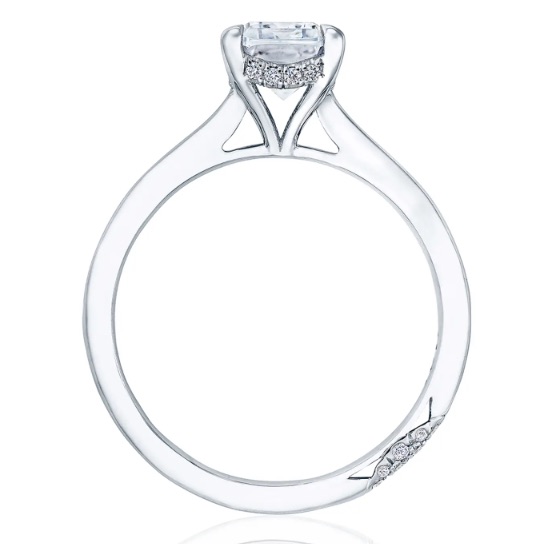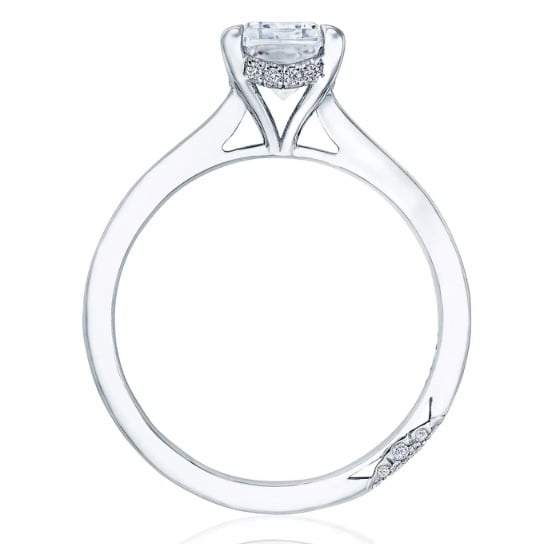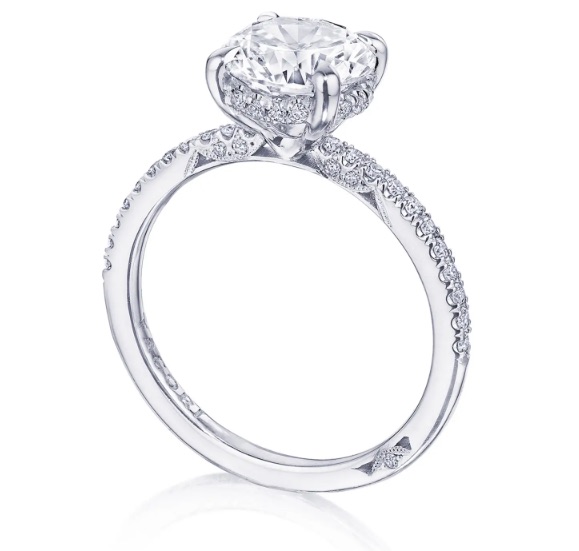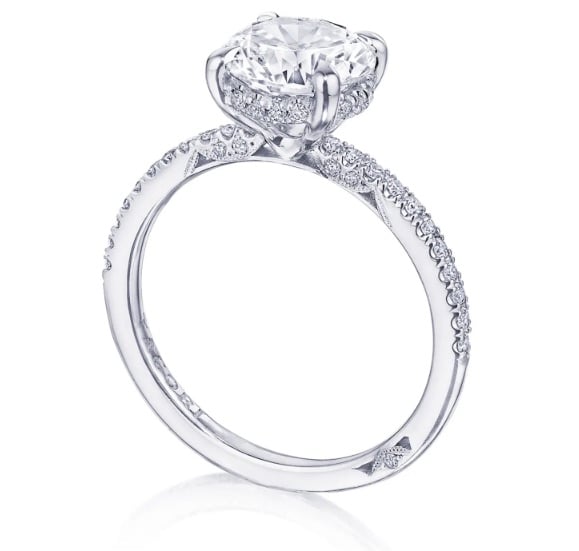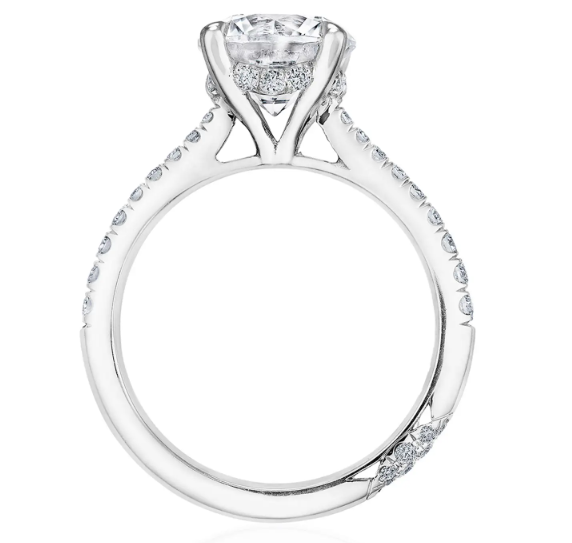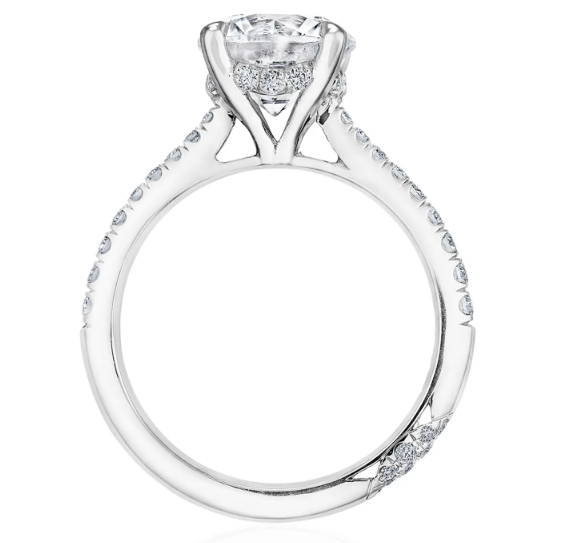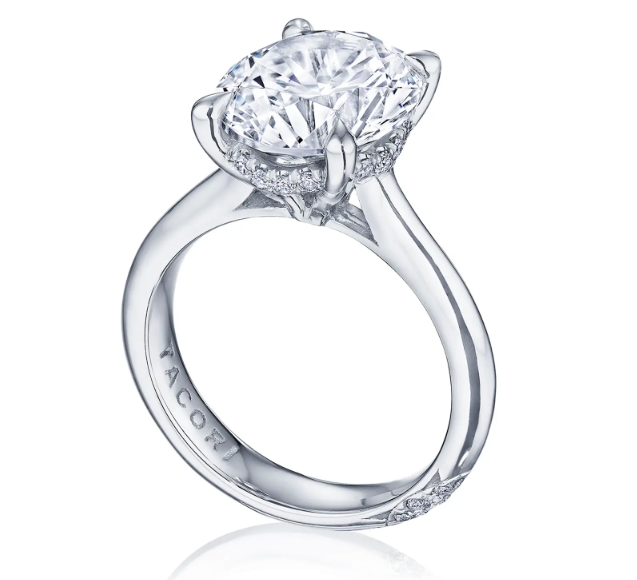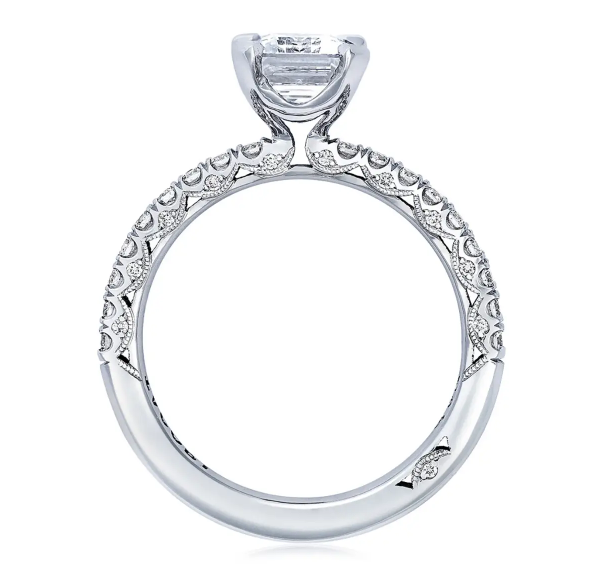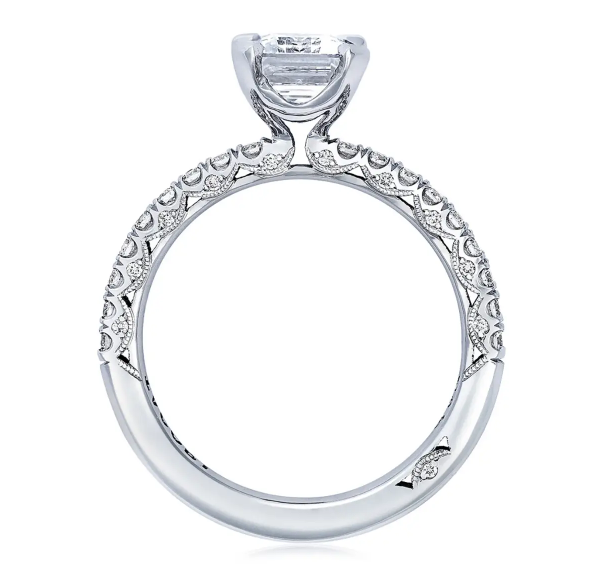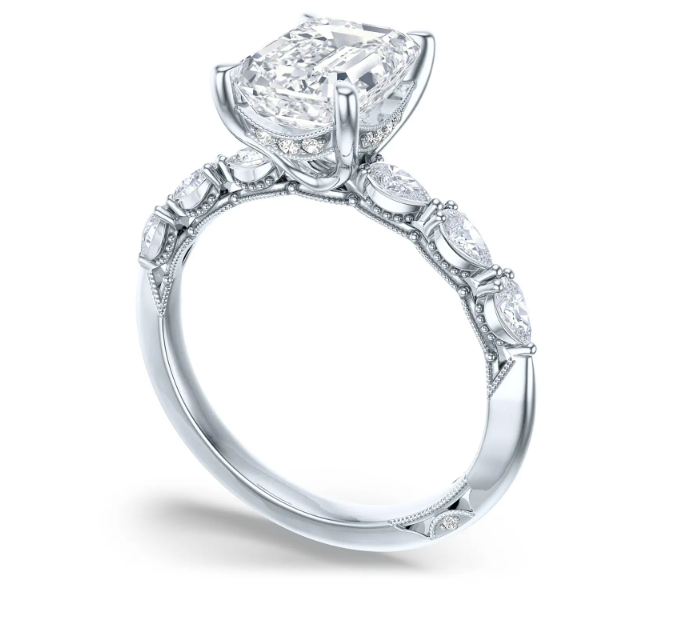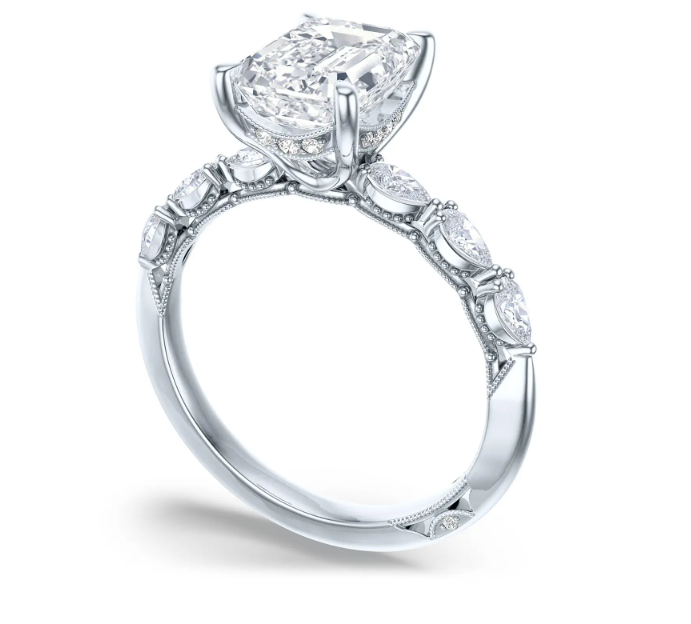
Did you know that white is the most popular metal color for engagement rings?
If you love the timeless look of bright white bridal jewelry, you’ll need to decide platinum engagement ring or 18k white gold engagement ring.
White gold and platinum look very similar, but each metal has its own unique characteristics of color, purity, strength, and price.
So how do you choose between platinum ring and white gold ring?
We recommend platinum as our preferred white metal for its durability, longevity, and natural white color. That's the short answer, but we'll go into more details below.
That said, both white gold and platinum are good choices when it comes to TACORI rings. That's because we make all of our metals in-house with proprietary formulas in order to make metals that meet our high standards. TACORI metals exceed the industry standards for purity and quality, and we often choose more expensive ingredients in mixing our alloys for the sake of the metal's shine and longevity.
What is an alloy?
An alloy is a mixture or combination of two or more elements, at least one of which is a metal. The elements are combined in specific proportions to create a new material with enhanced properties or characteristics not found in the individual elements. Alloys are typically created to improve the strength, hardness, corrosion resistance, or other desirable attributes of metals.
Here's a full run-down on TACORI's premium white metals to help decide which is right for you:
Choosing A White Metal Color For Your Engagement RIng
Platinum is naturally white and the purest of precious metals. The platinum that will form your TACORI engagement ring is 95% pure platinum, which is higher than the industry standard. Only the smallest amount of other platinum group metals are added to create an alloy that can be molded, cast, and shaped. Because platinum is naturally white, it won’t yellow over time and doesn’t need replating to retain its colorless luster. It will always remain the perfect colorless canvas to spotlight your diamonds.
On the other hand, gold is naturally yellow in color. Pure gold is known as 24k, but is much too soft to be worn alone. To achieve 18k white gold, we use 75% pure gold, mixed with white metals to form an alloy. Because of the yellowness of pure gold, the white gold alloy will always retain a slight yellowish color. Jewelers add a very thin coating of rhodium (a pure white metal) to give the 18k white gold its brilliant pure white appearance. This rhodium plating will wear off over time, and begin to reveal the yellowish hue underneath.
White Gold Replating
Rhodium replating is recommended regularly to retain the white finish. To ensure the most longevity in your rhodium plating, we recommend removing your white gold ring when applying cosmetics, hair spray, perfumes, lotions and avoiding exposure to saltwater and household cleaning supplies, as this can all lead to diminishing the ring's color.
Platinum Vs. White Gold - Metal Strength
Though both platinum and gold are strong and durable precious metals, platinum is the more durable of the two.
Platinum is approximately 40% heavier than 18k gold- when you hold it in your hand, you can feel the difference. Platinum's density provides its longevity and durability, and in turn, platinum prongs offer the best protection to secure your diamonds and gemstones.
A key difference between platinum and white gold is that if platinum gets scratched, it won't lose any volume. Instead, the scratched bit of metal simply moves, accommodating the dent; you may also hear this characteristic referred to as "patina". The patina is considered a mark of platinum's enduring strength; and it's what makes platinum pieces outlast a lifetime; platinum pieces are designed to be passed down from one generation to the next.
Pure gold is naturally soft, and the addition of alloys helps strengthen and improve the performance. While white gold is more scratch-resistant than platinum, it is important to note that when scratched, some of the gold is lost. Over time and with polishing, it is more likely that some gold will begin to wear away.
Due to the difference in platinum and white gold's composition, we do not recommend stacking or mixing gold with platinum rings as this can cause wear and tear on your gold ring(s).
Platinum Vs. White Gold - Which Is More Expensive?
In general, platinum will have a higher price tag than white gold. First and foremost, this is because of the density of platinum; more platinum is required to make a piece. In fact, platinum is approximately 40% heavier than 18 karat gold. Moreover, platinum is 30 times more rare than gold.
According to our friends at Platinum Guild International USA (PGI), "If all the platinum ever mined were melted and poured into an Olympic-sized pool, the platinum would barely reach your ankles, however, gold would fill three pools."
And finally, when you buy a platinum ring, you're paying for the purest of all precious metals rings. With platinum, you're investing in longevity.
White gold is a mixture of pure gold with durable metals. With less pure gold being used, the price is lower. Although you're paying less for white gold in the beginning, it will require more frequent professional maintenance to maintain its bright, white appearance in the long term.
When comparing both metals, price per gram, you won't notice a significant difference. But due to the different densities and the amount of each metal needed to make the same ring, whether you choose platinum or white gold will impact the final price of your ring.
White Gold Vs. Platinum - Metal Sensitivity
TACORI platinum is at least 95% pure platinum, making it the only hypoallergenic metal on the market. 'Hypoallergenic' means that the possibility of an allergic reaction is minimized. If you have sensitive skin or allergies to irritating substances, platinum is your safest bet.
White gold alloy includes a mix of metals, and certain materials of its composition may cause skin irritation if you have sensitive skin or certain allergies. While some brands use nickel in their white gold alloy, which is the culprit to most skin allergies, rest assured all TACORI metals are nickel-free, and we pride ourselves in using only the highest quality ingredients in our metal formula..
In TACORI's proprietary white gold formula, instead of using the common allergen of nickel, our white gold alloys are mixed with palladium rather than the using the common allergen of nickel. Palladium is actually more expensive per gram than the gold itself.
FAQ
Is platinum more valuable than white gold?
In general, platinum is considered more valuable than white gold due to its rarity and luxurious appeal. Platinum is a precious metal that is rarer and more difficult to mine and refine, making it costlier than white gold, which is an alloy of gold and other metals. However, market prices can fluctuate, so it's always a good idea to check current values with a jeweler or precious metals expert. TACORI's white gold alloy contains palladium, which makes it more valuable than a white gold alloy containing nickel.
Is platinum whiter than white gold?
Platinum looks whiter than gold because it has a natural white color, while gold has a yellowish hue. Even white gold, which is an alloy of gold and other metals, might have a slight yellowish tint compared to platinum. Platinum's naturally bright and white appearance makes it highly valued in jewelry.
To recap - and for all the visual folks out there - we made this handy chart to help differentiate between platinum vs white gold. 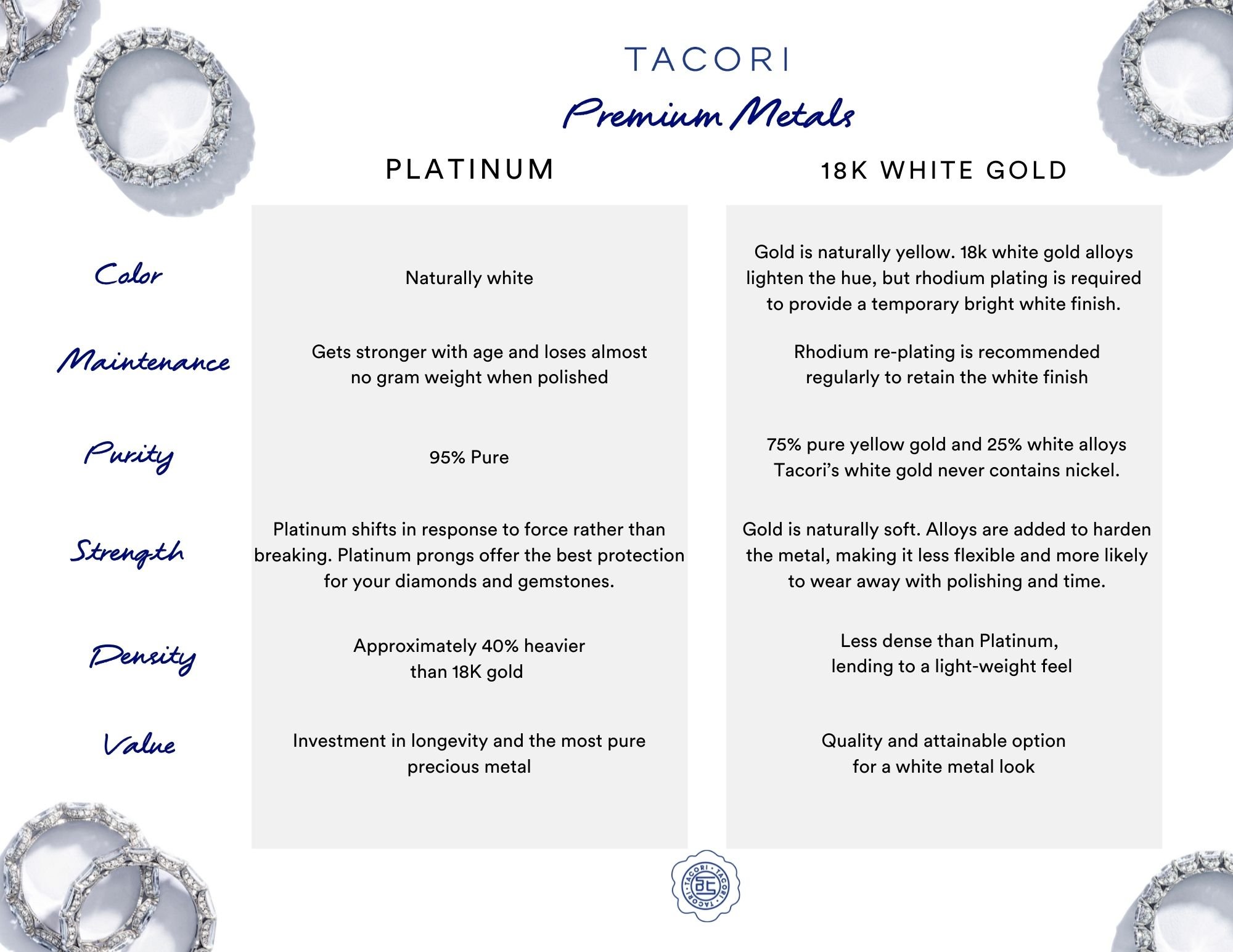
More TACORI:
- The 4 Ps of Platinum
- Precious Metal Guide
- 4 Reasons We Prefer Platinum Engagement Rings and Wedding Bands
- Yellow Gold Engagement Rings
- Rose Gold Engagement Rings


